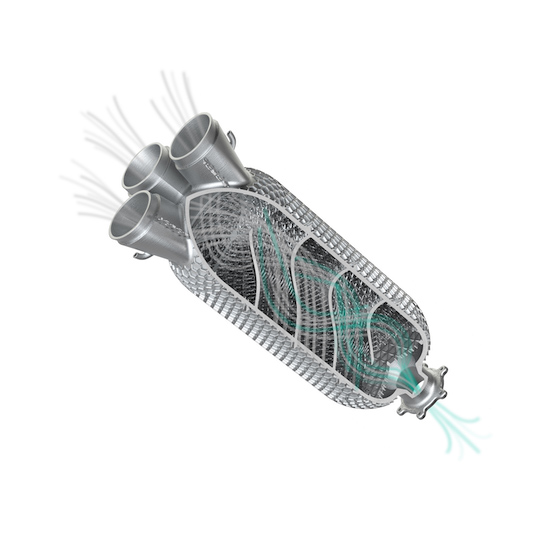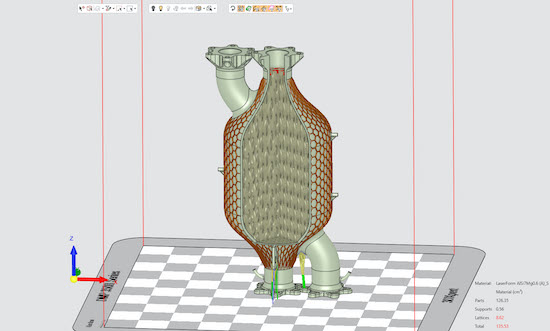The Role of Additive Manufacturing in Combating Climate Change
The use of additive manufacturing can optimize efforts to create new carbon capture solutions.
Latest News
December 19, 2022
Now that we are more than two decades into the current century, the importance of combating climate change is accelerating. The Paris Agreement 2050 has highlighted the need for steep emissions cuts within the decade to keep global warming to no more than 1.5°C and safeguard a livable climate, as outlined in the UN Net-zero Coalition. To accomplish this, heavy industrial manufacturers are quickly setting up operations with large investments, and tech start-ups are creating novel solutions. Despite investment by industrial manufacturers to solve this issue, and tech start-ups creating novel solutions, global targets are not being met.
At the heart of carbon capture are some relatively simple chemical reactions. Any carbon capture and reclamation system must operate at extreme efficiency to ensure it is not adding to the problem by consuming carbon-heavy fuels or emitting further carbon into the atmosphere. In other words, we must capture as much carbon as possible while using significantly less carbon than we are capturing to produce the reaction. Ideally, the goal is zero carbon input for unlimited carbon reclaimed as output.
To solve the problem, carbon-negative infrastructure is required. The most efficient, effective, scalable method to help lower CO2 emissions is the use of direct air capture (DAC). Direct Air Capture is a technology that enables the separation of CO2 from air to create the products the economy needs - such as agricultural products, building materials, fuels, plastics, and chemicals. DAC also enables sequestration - the ability to store CO2 for constructive purposes - turning it from a threat to an opportunity.
Benefits of Additive Manufacturing
Removing carbon from the atmosphere requires a system of filters, heat exchangers, condensers, gas separators, and compressors. Many of these complex parts require geometries that are well-suited to additive manufacturing, which is more efficient and potentially more cost-effective than traditional fabrication methods, and delivers substantial performance and economic benefits in DAC equipment:
Design Optimization for Energy Efficiency: When we direct the design optimization capability of additive manufacturing toward these carbon capture and utilization systems, we have the potential to dramatically boost performance and efficiency, approaching lossless energy.
Design Freedom: Additive manufacturing enables freedom of design to express the novel architecture required to efficiently capture and process carbon from the atmosphere and do something useful with it.
Performance: Capable of production with a range of alloys that are high temperature and corrosion-resistant while possessing high thermal conductivity.
Scalability: Rapidly available via scalable manufacturing to support the massive need in the field for equipment.
Supply Chain Efficiencies: Part consolidation and monolithic design, which enables quality and streamlining of the supply chain. We cannot overlook the carbon footprint of using multiple suppliers across the country to produce a single assembly.
Additive Manufacturing satisfies all of the requirements for the production of such reactors and can enable applications that address a variety of needs for carbon capture.
Microturbine Equipment
Microturbines are an emerging technology in various industries, including power generation. They present an opportunity to provide high-pressure, high-efficiency gas and fluid conveyance, in a small form factor, with a minimal energy/carbon footprint. Efficiency in carbon capture is much like power generation in general, it is a function of yield over energy input.
High performance, reliability, air compression, and system pressure stability are critical to the function of carbon capture systems now, and more importantly, in the future. As industrial carbon capture systems trend towards more commercial units, with distributed production and operation, it’s even more critical to make use of novel, compact turbine technology to enable high efficiency, small footprint operation.
Mechanical Filters
A critical component of carbon capture is “catching” the carbon in the first place with a structured mechanical filter, typically coated with an Amine that attracts carbon. Air is drawn into the system through the first stage which is the “direct air contact” stage. Direct air contact filter efficiency can be maximized by filter structures that allow for maximum contact between incoming air and the filter surface. Additive manufacturing allows for the function-first design of such filters which can induce high levels of turbulence and mixing as well as high surface area for maximum air contact.
The typical values are at play here. The challenge is, how do we make the maximum amount of surface area with the least pressure drop?

Heat Exchangers
Heat waste is a common problem in carbon capture. Carbon captured in the first direct air contact stage must be evacuated from mechanical filters into downstream refinement stages. In many embodiments of the technology, this is done via pressurized steam liberating the carbon from the filter. Heat exchangers can be applied to eliminate surplus heat from the steam generation process, and more commonly downstream reducing the temperature of the carbon-rich steam which exits the filter stage. Furthermore, novel heat exchange strategies are coupled with downstream distillation and refinement steps to keep the process at a stable temperature to sustain chemical reaction and produce output carbon product.

Diffuser Plates
Diffuser plates are commonly applied in chemical processing to take some volume of gas or fluid and collimate it. Fluid diffusion works similarly to the concept of light collimation which takes a light source and organizes the energy so that light is emitted diffusely with parallel beam paths. Diffusor plates are very similar to a garden hose spray nozzle which takes a chaotic fluid flow and produces a structured and even flow. Liquid diffuser plates are important components of process stacks to ensure uniform flow and treatment of carbon-rich fluid as it flows through the process.
Additive manufacturing allows for large volume diffusor plates to provide high-efficiency fluid diffusion primarily by enabling design complexity in diffusor plate shape but also diffusor nozzle shape. Borrowing concepts from aerospace fuel nozzle design, and semiconductor capital equipment showerhead applications, additively manufactured diffusor plates can be manufactured 20X faster than with machining alone.
Chillers and Distillers
The carbon-rich product which exits the filter stage can be considered “dirty” and in need of further processing to be usable. This dirty carbon post-processing can be accomplished outside of a self-contained system, but it implies even more carbon will be produced in the logistics of collecting and transporting dirty carbon product to secondary post-processing facilities. The most valuable, and promising carbon capture systems have some level of integrated dirty carbon product post-processing such that the output of a carbon capture system consists of clean usable carbon product, and safe water-based byproduct.
Refinement columns which can include distillers with integrated chilling, and heat exchangers are relatively complex to assemble traditionally, with dozens of sheet metal shells and stages - as many as hundreds of yards of bent tube - and dozens of flanges, fittings, and manifolds which may be machined or cast. All of this needing to be procured and assembled further increases the collective carbon output and pollution caused by merely manufacturing the components and assembling them.
Additive manufacturing allows for extensive part consolidation and monolithic design, which enables significant consolidation and streamlining of the supply chain. It also enables function-first, highly efficient design which can accelerate the refinement stage thus providing even more output in a smaller form factor.
Manifolds (Liquid, Gas, and Vapor)
Carbon capture is a chemical process, which involves fluid and gas combined with chemistry, temperature, and pressure. Manifold applications in carbon capture are numerous ranging from chemistry conveyance into process chambers, to efficient distribution of coolant to active cooling components such as heat exchangers, as well as general gas distribution applications. What makes these components challenging to produce is not the requirements for chemical resistance or aerospace-grade special materials, but rather the need for balanced pressure across many branching lines, and even delivery of fluids through a process chamber. Efficient one-to-many branching with even fluid flow combined with space and assembly restrictions is a geometry problem that additive manufacturing is uniquely positioned to enable, as evidenced by the adoption of the technology in aerospace, defense, and semiconductor capital equipment today.
The Possibility of a Future When We Can Breathe Easier
Direct Air Capture and refinement is a critical technology for correcting atmospheric carbon levels, and additive manufacturing is currently enabling significant efficiency advances in the technology. 3D Systems and AirCapture are making great strides in our collaboration by utilizing AM to quickly iterate and manufacture production-ready components. We’re able to apply never before used, high-efficiency geometry to process stacks and thermal exchange that is increasing capture efficiency while reducing form factor and footprint, making the technology easy to install and ultimately scale. With further adoption of advanced manufacturing technology and design tools, we believe we can rest a bit easier knowing that the climate may still be comfortable and livable for future generations.
More 3D Systems Coverage
Subscribe to our FREE magazine, FREE email newsletters or both!
Latest News






